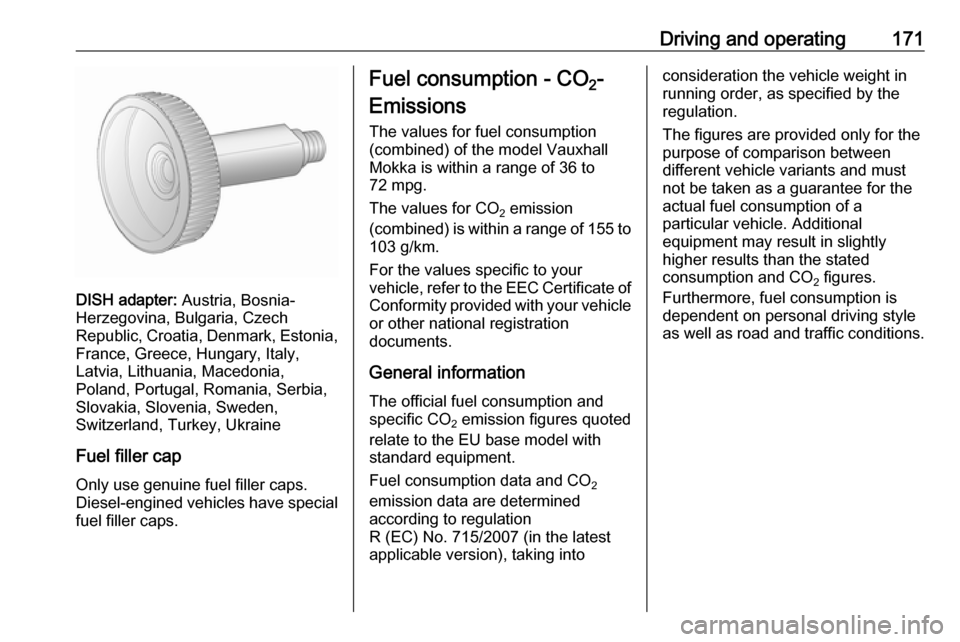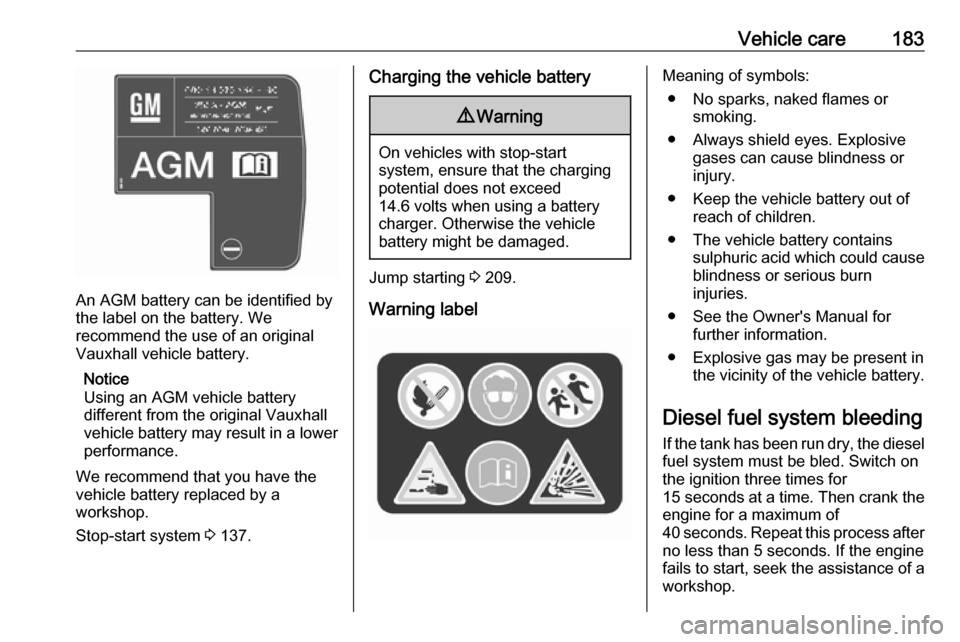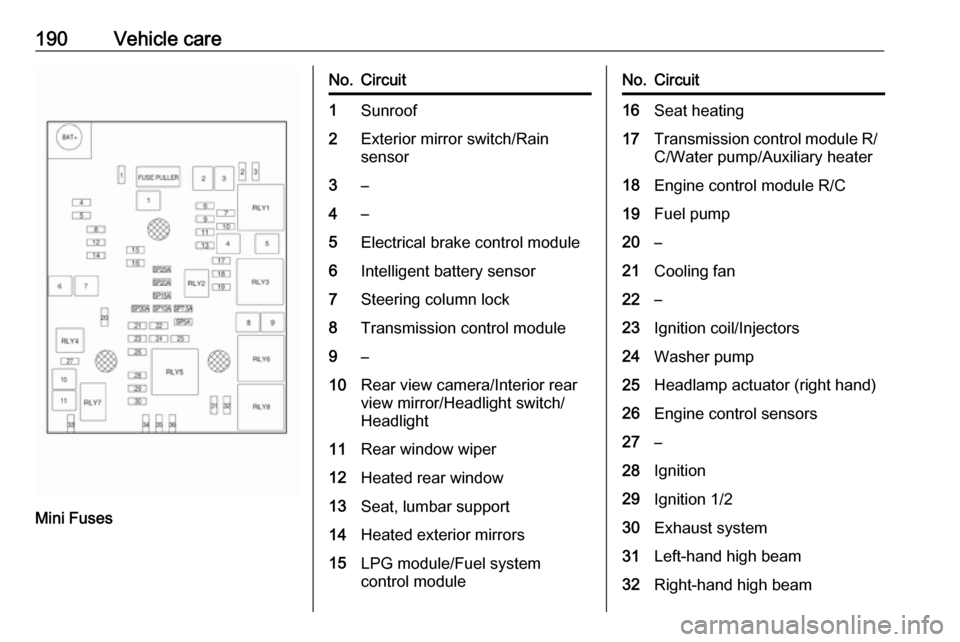AUX VAUXHALL MOKKA X 2017 User Guide
[x] Cancel search | Manufacturer: VAUXHALL, Model Year: 2017, Model line: MOKKA X, Model: VAUXHALL MOKKA X 2017Pages: 245, PDF Size: 6.77 MB
Page 172 of 245

170Driving and operatingPress the button at the liquid gas
supply point. The filling system stops
or begins to run slowly when 80% of
the tank volume is reached
(maximum fill level).
Release button on filling system and
the filling process stops. Release the
locking lever and remove the filler nozzle. A small quantity of liquid gas
may escape.
Remove adapter and stow in vehicle.
Fit protective cap to prevent the
penetration of foreign bodies into the
filler opening and the system.9 Warning
Due to the system design, an
escape of liquid gas after
releasing the locking lever is
unavoidable. Avoid inhaling.
9 Warning
The liquid gas tank should only be
filled to 80% capacity, for safety
reasons.
The multivalve on the liquid gas tank
automatically limits the fill quantity. If
a larger quantity is added, we
recommend not exposing the vehicle
to the sun until the excess amount
has been used up.
Filling adapter
As filling systems are not
standardised, different adapters are
required which are available from
Vauxhall Distributors and from
Vauxhall Authorised Repairers.
ACME adapter: Belgium, Germany,
Ireland, Luxembourg, Switzerland
Bayonet adapter: Netherlands,
Norway, Spain, United Kingdom
EURO adapter: Spain
Page 173 of 245

Driving and operating171
DISH adapter: Austria, Bosnia-
Herzegovina, Bulgaria, Czech
Republic, Croatia, Denmark, Estonia, France, Greece, Hungary, Italy,
Latvia, Lithuania, Macedonia,
Poland, Portugal, Romania, Serbia,
Slovakia, Slovenia, Sweden,
Switzerland, Turkey, Ukraine
Fuel filler cap
Only use genuine fuel filler caps. Diesel-engined vehicles have special
fuel filler caps.
Fuel consumption - CO 2-
Emissions The values for fuel consumption
(combined) of the model Vauxhall
Mokka is within a range of 36 to
72 mpg.
The values for CO 2 emission
(combined) is within a range of 155 to 103 g/km.
For the values specific to your
vehicle, refer to the EEC Certificate of
Conformity provided with your vehicle
or other national registration
documents.
General information
The official fuel consumption and
specific CO 2 emission figures quoted
relate to the EU base model with
standard equipment.
Fuel consumption data and CO 2
emission data are determined
according to regulation
R (EC) No. 715/2007 (in the latest
applicable version), taking intoconsideration the vehicle weight in
running order, as specified by the
regulation.
The figures are provided only for the
purpose of comparison between
different vehicle variants and must
not be taken as a guarantee for the
actual fuel consumption of a
particular vehicle. Additional
equipment may result in slightly
higher results than the stated
consumption and CO 2 figures.
Furthermore, fuel consumption is
dependent on personal driving style
as well as road and traffic conditions.
Page 178 of 245

176Vehicle careVehicle careGeneral Information...................176
Accessories and vehicle modifications .......................... 176
Vehicle storage ........................177
End-of-life vehicle recovery .....177
Vehicle checks ........................... 178
Performing work ......................178
Bonnet ..................................... 178
Engine oil ................................. 179
Engine coolant ......................... 180
Power steering fluid .................180
Washer fluid ............................ 181
Brakes ..................................... 181
Brake fluid ............................... 181
Vehicle battery ......................... 182
Diesel fuel system bleeding .....183
Wiper blade replacement ........184
Bulb replacement .......................185
Halogen headlights ..................185
Fog lights ................................. 186
Tail lights ................................. 187
Number plate light ...................188
Electrical system ........................189
Fuses ....................................... 189
Engine compartment fuse box . 189Instrument panel fuse box .......191
Load compartment fuse box ....193
Vehicle tools .............................. 194
Tools ........................................ 194
Wheels and tyres .......................195
Winter tyres ............................. 195
Tyre designations ....................195
Tyre pressure .......................... 195
Tyre pressure monitoring system .................................... 196
Tread depth ............................. 200
Changing tyre and wheel size . 201
Wheel covers ........................... 201
Tyre chains .............................. 201
Tyre repair kit .......................... 202
Wheel changing .......................205
Spare wheel ............................ 207
Jump starting ............................. 209
Towing ....................................... 211
Towing the vehicle ...................211
Towing another vehicle ...........212
Appearance care .......................213
Exterior care ............................ 213
Interior care ............................. 215General Information
Accessories and vehicle modifications
We recommend the use of genuine
parts and accessories and factory
approved parts specific for your
vehicle type. We cannot assess or
guarantee reliability of other products
- even if they have a regulatory or
otherwise granted approval.
Any modification, conversion or other
changes made to standard vehicle
specifications (including, without
limitation, software modifications,
modifications of the electronic control units) may invalidate the warrantyoffered by Vauxhall. Furthermore,
such changes may impact fuel
consumption, CO 2 emissions and
other emissions of the vehicle and
cause the vehicle to no longer
conform to the type approval,
impacting the validity of your vehicle
registration.
Page 185 of 245

Vehicle care183
An AGM battery can be identified by
the label on the battery. We
recommend the use of an original
Vauxhall vehicle battery.
Notice
Using an AGM vehicle battery
different from the original Vauxhall
vehicle battery may result in a lower performance.
We recommend that you have the
vehicle battery replaced by a
workshop.
Stop-start system 3 137.
Charging the vehicle battery9 Warning
On vehicles with stop-start
system, ensure that the charging potential does not exceed
14.6 volts when using a battery
charger. Otherwise the vehicle
battery might be damaged.
Jump starting 3 209.
Warning label
Meaning of symbols: ● No sparks, naked flames or smoking.
● Always shield eyes. Explosive gases can cause blindness or
injury.
● Keep the vehicle battery out of reach of children.
● The vehicle battery contains sulphuric acid which could cause
blindness or serious burn
injuries.
● See the Owner's Manual for further information.
● Explosive gas may be present in the vicinity of the vehicle battery.
Diesel fuel system bleeding If the tank has been run dry, the diesel
fuel system must be bled. Switch on
the ignition three times for
15 seconds at a time. Then crank the
engine for a maximum of 40 seconds. Repeat this process after
no less than 5 seconds. If the engine fails to start, seek the assistance of a
workshop.
Page 192 of 245

190Vehicle care
Mini Fuses
No.Circuit1Sunroof2Exterior mirror switch/Rain
sensor3–4–5Electrical brake control module6Intelligent battery sensor7Steering column lock8Transmission control module9–10Rear view camera/Interior rear
view mirror/Headlight switch/
Headlight11Rear window wiper12Heated rear window13Seat, lumbar support14Heated exterior mirrors15LPG module/Fuel system
control moduleNo.Circuit16Seat heating17Transmission control module R/ C/Water pump/Auxiliary heater18Engine control module R/C19Fuel pump20–21Cooling fan22–23Ignition coil/Injectors24Washer pump25Headlamp actuator (right hand)26Engine control sensors27–28Ignition29Ignition 1/230Exhaust system31Left-hand high beam32Right-hand high beam
Page 194 of 245

192Vehicle careNo.Circuit1Body control module2Body control module3Body control module4Body control module5Body control module6Body control module7Body control module8Body control module9Ignition switch10Safety diagnosis module11Data link connector12Climate control13Tailgate14Central gateway module15Lane departure warning/Interior
mirror16Adaptive forward lighting17Column lockNo.Circuit18Ultrasonic park assist module19Body control module/Regulated
voltage control20Steering wheel21–22Cigarette lighter/DC accessory
power outlet (front)23Cigarette lighter/DC accessory
power outlet (rear center
console)24Spare25Telematics service module26Heated steering wheel27Instrument panel cluster/Info‐
tainment system/Auxiliary
heater switch28Trailer socket29Display/Infotainment system30Transmission control moduleNo.Circuit31Instrument panel cluster32Infotainment system33Trailer socket34Passive entry/Passive start
module
S/B Fuses
No.Circuit01Power seat switch02Spare03Power windows front04Power windows rear05Logistic mode06Power seat switch07Spare08Spare
Page 204 of 245

202Vehicle careOn tyres of size 215/65 R16 and215/60 R17 always use fine mesh
chains suitable for sport utility
vehicles that add no more than
9 mm to the tyre tread and the inboard sides (including chain lock).
On tyres of size 215/55 R18 only use special snow chains which are
permitted for Vauxhall Mokka and
tyres of these sizes. For further
information contact a workshop.
The use of tyre chains is not permitted on the temporary spare wheel.
Tyre repair kit Minor damage to the tyre tread can be
repaired with the tyre repair kit.
Do not remove foreign bodies from
the tyres.
Tyre damage exceeding 4 mm or that is at tyre's sidewall cannot be repairedwith the tyre repair kit.9 Warning
Do not drive faster than 50 mph.
Do not use for a lengthy period.
Steering and handling may be
affected.
If you have a flat tyre:
Apply the parking brake and engage
first gear, reverse gear or P.
The tyre repair kit is located in the
right side of rear compartment.
1. Take the tyre repair kit from the compartment.
2. Remove the compressor.
Page 239 of 245

Customer information237When using the vehicle, situations
may occur in which these technical
data related to other information
(accident report, damages on the
vehicle, witness statements etc.) may
be associated with a specific person - possibly, with the assistance of an
expert.
Additional functions contractually
agreed upon with the client (e.g.
vehicle location in emergency cases)
allow the transmission of particular vehicle data from the vehicle.
Radio Frequency
Identification (RFID)
RFID technology is used in some
vehicles for functions such as tyre
pressure monitoring and ignition
system security. It is also used in
connection with conveniences such
as radio remote controls for door
locking/unlocking and starting, and in-
vehicle transmitters for garage door
openers. RFID technology in
Vauxhall vehicles does not use or
record personal information or link with any other Vauxhall system
containing personal information.
Page 240 of 245

238IndexAAccessories and vehicle modifications .......................... 176
Adaptive forward lighting .....95, 118
Adjustable air vents ...................130
Airbag and belt tensioners ...........91
Airbag deactivation ................51, 92
Airbag label................................... 46 Airbag system .............................. 46
Air conditioning regular operation ................................ 131
Air conditioning system .............. 126
Air intake .................................... 130
Air vents...................................... 130
All-wheel drive ........................... 146
Antilock brake system ................ 147
Antilock brake system (ABS) .......92
Anti-theft alarm system ................29
Anti-theft locking system .............. 29
Appearance care ........................213
Automatic anti-dazzle ..................33
Automatic light control ...............115
Automatic locking ........................27
Automatic transmission .............142
Autostop ..................................... 137
Auxiliary heater ........................... 129
B Battery discharge protection ......124
Battery voltage ........................... 103Bicycle rack .................................. 60
Bonnet ....................................... 178
Brake and clutch fluid .................217
Brake and clutch system .............92
Brake assist ............................... 148
Brake fluid .................................. 181
Brakes ............................... 147, 181
Breakdown.................................. 211
Bulb replacement ....................... 185
C
Capacities .................................. 229
Catalytic converter .....................141
Central locking system ................23
Centre console storage ...............60
Changing tyre and wheel size ...201
Charging system .......................... 92
Child locks ................................... 28
Child restraint installation locations ................................... 53
Child restraints.............................. 52
Child restraint systems ................52
Climate control ............................. 15
Climate control systems .............125
Clock............................................. 80
Code ........................................... 102
Collision damage repair ..............234
Control indicators.......................... 86
Control of the vehicle .................133
Controls ........................................ 76